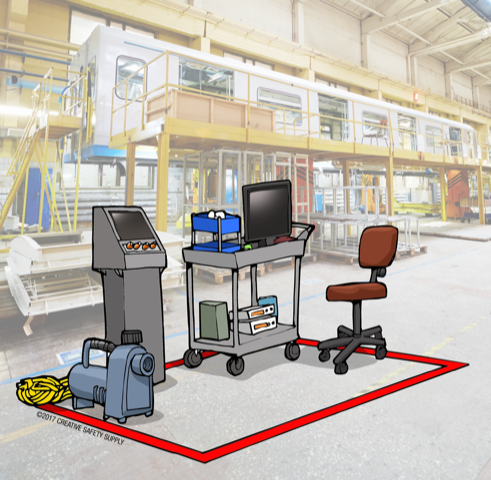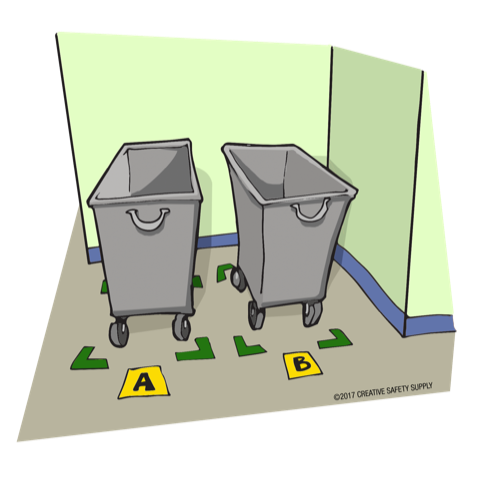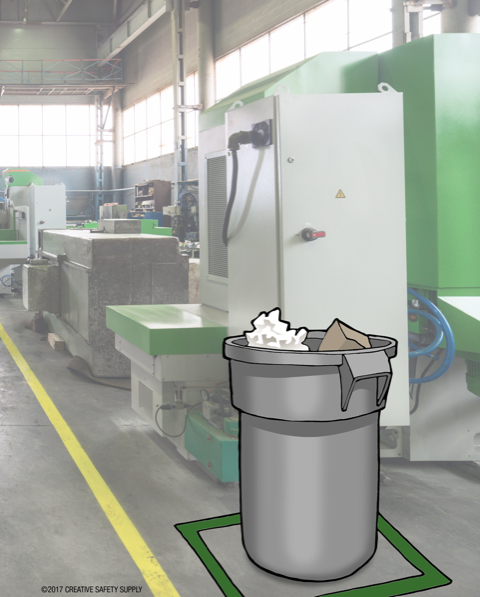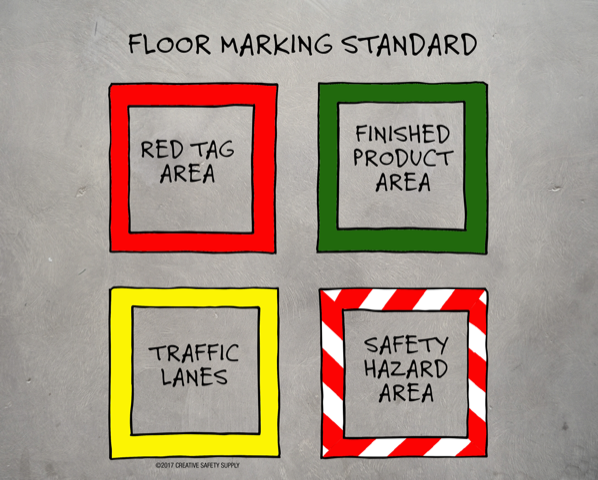Floor Marking and 5S
Far more than colorful lines and simple geometric shapes that help mitigate hazards, floor marking is a useful organizational tool that can prove invaluable for anyone designing a straightforward 5S program. In the same way that floor marking can be used to delineate hazards within the workplace, it can also be used as a vivid visual reminder of where tools should be, where a workspace begins and ends, and how traffic should flow through an area. This allows floor marking to be used to not only improve safety but to also enhance overall efficiency and reduce time and money losses related to confusion over how processes should flow and where tools and materials should be located.
Five Pillars, Five Floor Marking Opportunities
If you're a safety expert, you already know that 5S is an increasingly popular methodology for improving workplace efficiency. It includes five Japanese terms, which describe each pillar of the 5S process. In order, they include seiri (sort), seiton (set in order), seiso (shine, as in polish), seiketsu (standardize), and shitsuke (sustain). We'll take a brief look at each of these pillars and offer helpful examples of how floor marking can be utilized to enhance your 5S efforts.
Seiri (Sort)
The first pillar of 5S can be described as a cleaning effort. The goal is to make work easier and more efficient by leaving only crucial, must-have items in the workspace, such as tools and materials. Anything that is not used in the completion of a worker's prescribed task is removed. If these extraneous items can't be disposed of immediately, they should be placed into a dedicated Red Tag area for later disposal.

Seiton (Set in Order)
Though the second 5S pillar is concerned primarily with sorting all necessary items into appropriate places, the key to success here is repetition. It's not enough to simply put something in the right place once; You must put it in the right place each time it's used. Through repetition, it becomes increasingly easy to find the right tool or materials as they're needed, which makes all tasks flow more smoothly.
Floor marking proves invaluable here, as it helps to create discrete locations for tools, materials, and anything else a worker may need. Outlining the position of objects in a workspace ensures that they'll find their way back in the event that they need to be used elsewhere in the facility.

Seiso (Shine)
This too is a pillar in which floor marking can shine (pardon the pun).
The seiso pillar has two components: The cleaning of the workspace, and the maintenance of this cleanliness into the future. The core idea is that a clean workspace is less likely to fall into disorder, and that by focusing on maintaining a high level of cleanliness, workers are actively engaged in fighting off the chaos that inevitably creeps into any workspace over time. Floor markings can aid in these efforts by clearly blocking off areas for cleaning, storage, transit, and any other task that may occur in the workspace.

Seiketsu (Standardize)
The fourth S, seiketsu, is concerned with standardization. This is the pillar in which all of the progress created by the cleaning and organization efforts of the first three pillars is formalized into a set of procedures that can be utilized well into the future. Repetition of these procedures cements them into a worker's daily routine, driving further increases in efficiency, safety, and productivity. Thoughtful floor marking is useful here as it creates a vibrant, visual reminder of the processes that have been created, and the need to keep the workspace in order.

Shitsuke (Sustain)

Finally, we come to shitsuke, the last of the 5S pillars. The goal of shitsuke is instilling in workers and management a sense of self-discipline through which they can maintain the benefits created by the first four pillars. If employees are inherently motivated to take progressive action toward maintaining and improving their workspace, the workspace is far less likely to become chaotic, dangerous, and inefficient. Here, the floor markings you've placed as part of the prior four pillars, serve as unmistakable reminders of a facility's ongoing 5S efforts, and, in turn, keep workers and management focused on proactive maintenance and improving efficiency when possible.
How you utilize floor marking to enhance your 5S efforts is up to you, but keep in mind that they aren't solely useful for indicating directions and blocking off areas. Clearly defined borders ingrain themselves in the minds of workers, gradually granting them an inherent understanding of where things should go, and how processes flow from one area to another. In turn, this allows for even greater efficiency enhancements as those people most familiar with each process -- those workers directly involved in said process -- are given the opportunity to point out flaws and productivity bottlenecks.
Floor Marking Colors
OSHA and ANSI have made color floor marking color recommendations and regulations, so it is easy for someone who is not familiar with your facility's color scheme to make quick, educated, and safe decisions. For instance, OSHA regulations require that permanent aisles and passageways be marked and ANSI Z535.2 Safety Color Code designates yellow as the caution color to be used for marking physical hazards such as stumbling, falling or tripping points.
Aside from safety, there are basic organization color guidelines used across industries:
- White tape is used to designate the homes of any bins, racks, fixtures, or other facility items of this nature.
- Green, blue, or black tape are typically used interchangeably near raw materials, finished goods, and works in progress.
- Orange tapeis a great, noticeable color to represent items, supplies, or materials being help for inspection.
- Red tape may be the clear choice for outlining the red tag holding area, but it is also a popular option for any scrap or rework piles.
After planning out a color-coding strategy for floor markings, ensure its success by taking the time to be consistent across the facility and schedule training for all employees. Additionally, you should post a chart detailing the colors being used and what they mean in a central location.
Industrial floor marking tapes are recognized as the most convenient and inexpensive way to mark aisles since painted lines tend to chip, peel and crack especially in areas with heavier traffic. When it comes to the installation or application of floor marking, you will notice how much less of a hassle floor tape is. When painting floors, organizations will need to schedule a minimum of one day of stopped work for the paint to safely dry and cure.
The required minimum width for facility aisle and floor marking lines is 2". It is standard to use floor tapes between 2" and 6" wide, depending on the applications.
Whether you're completely new to floor marking, or have been marking facilities for years, Creative Safety Supply offers everything you'll need to support a burgeoning 5S plan. From ultra-durable floor marking supply to industrial printers that craft exactly the sign you need when you need it, we make it easy to boost safety and efficiency throughout your facility.




